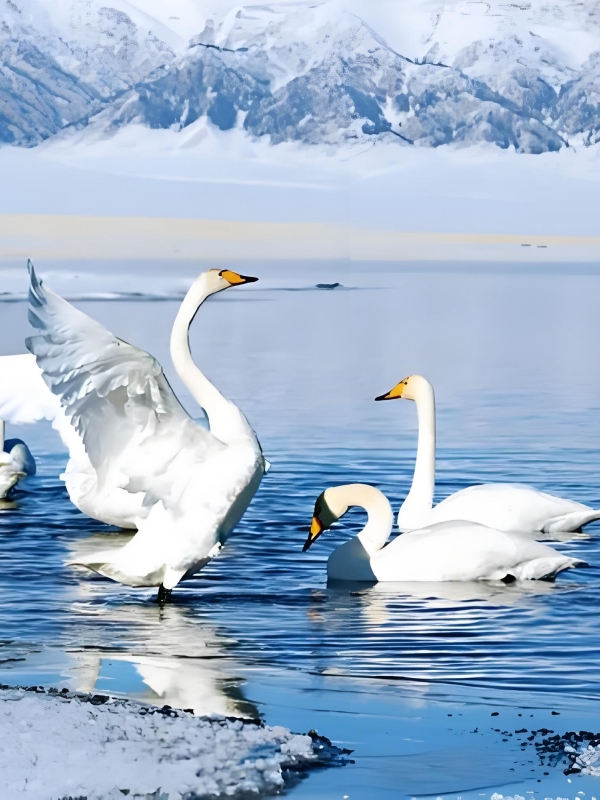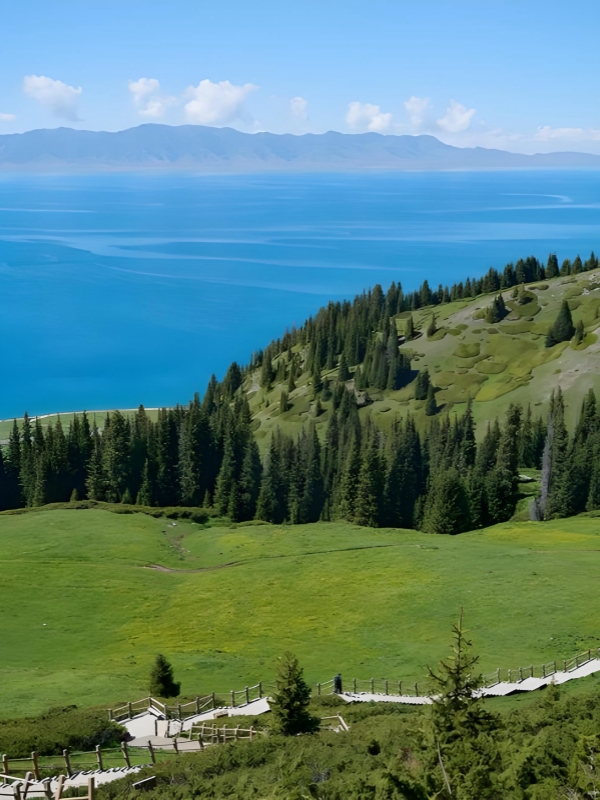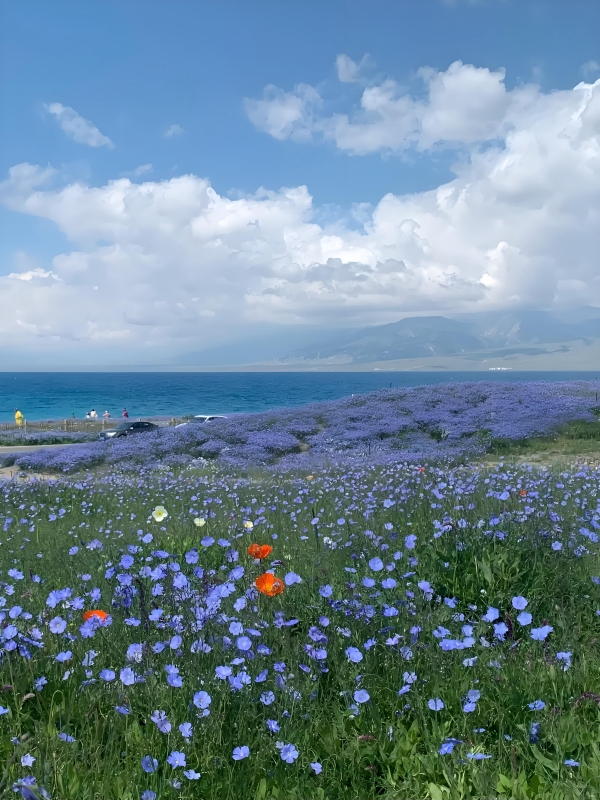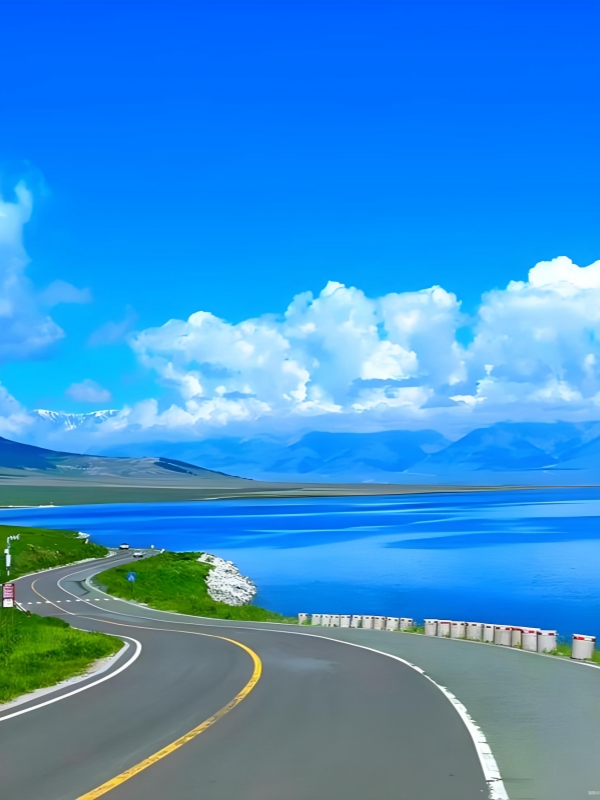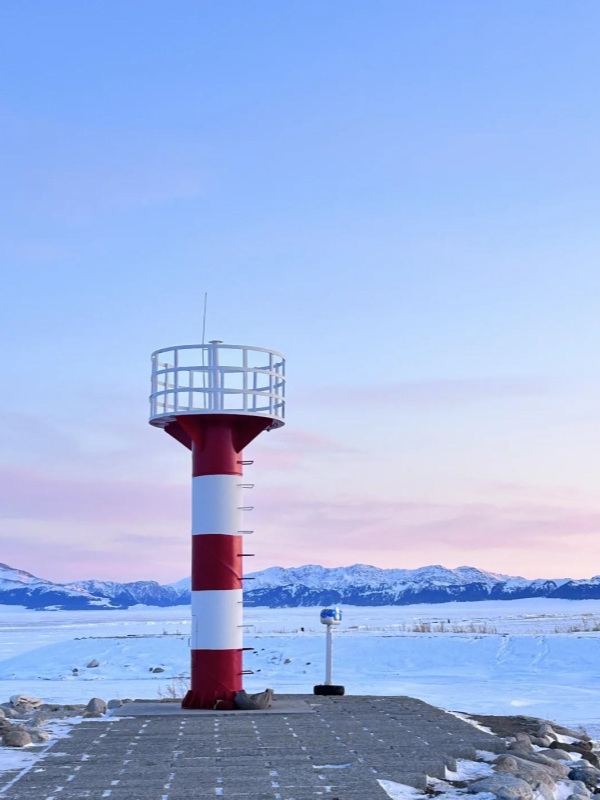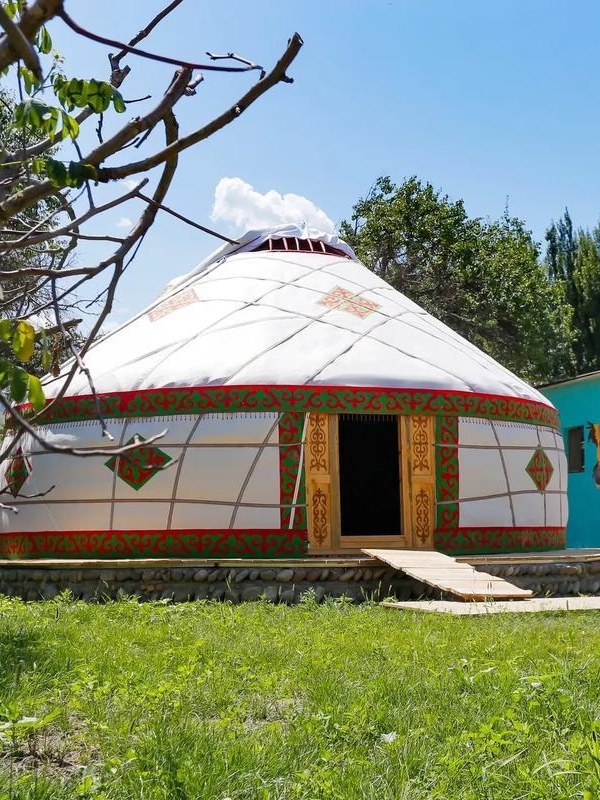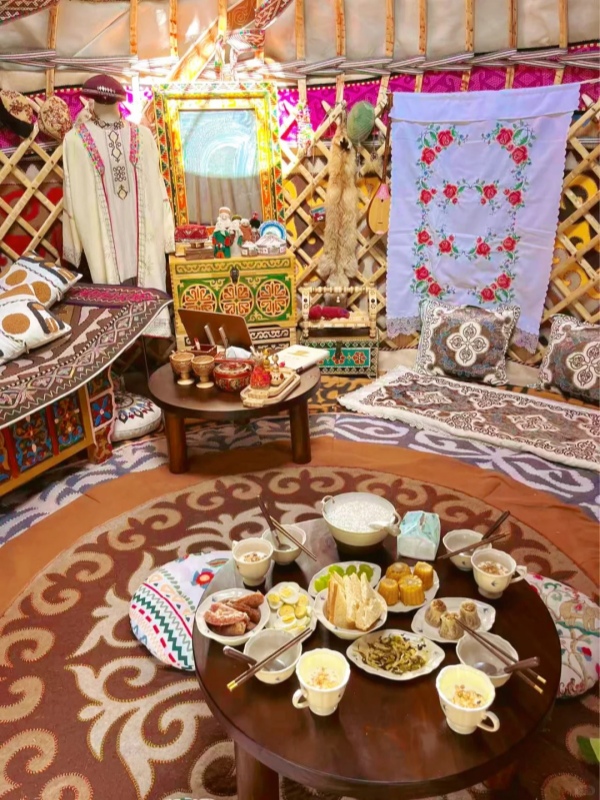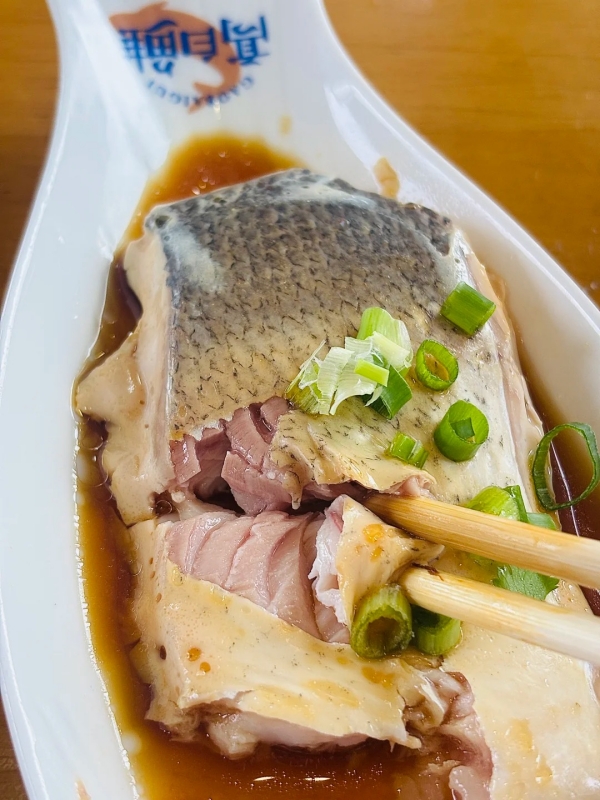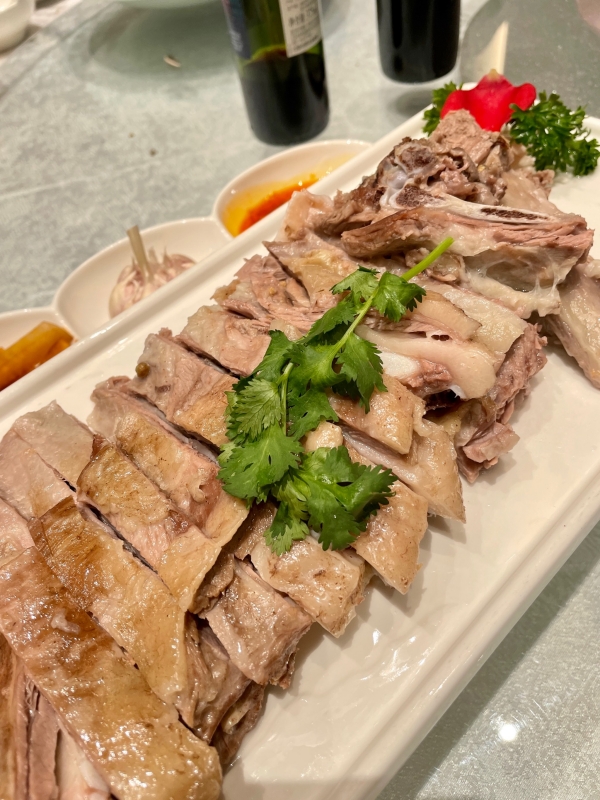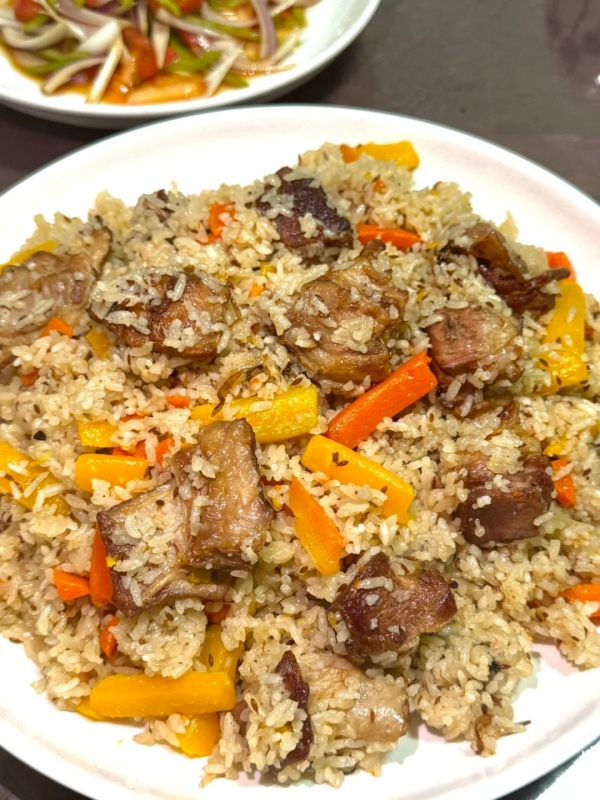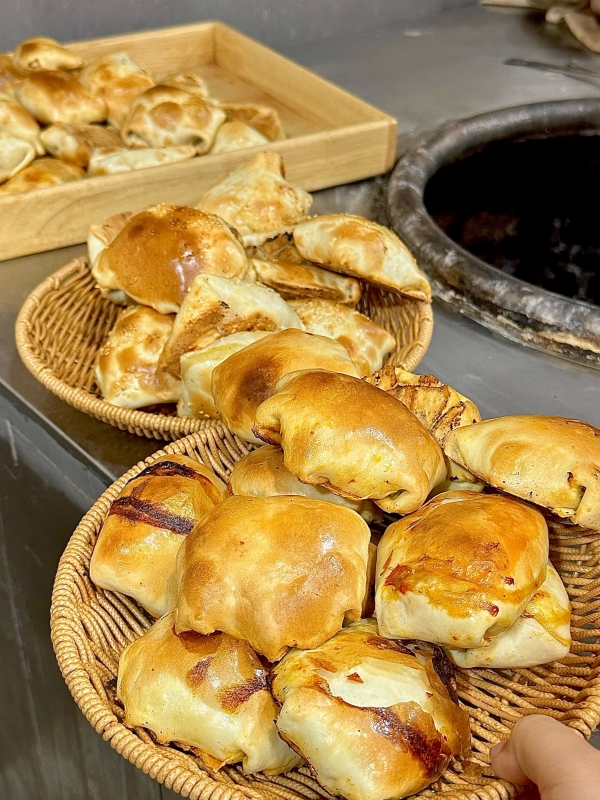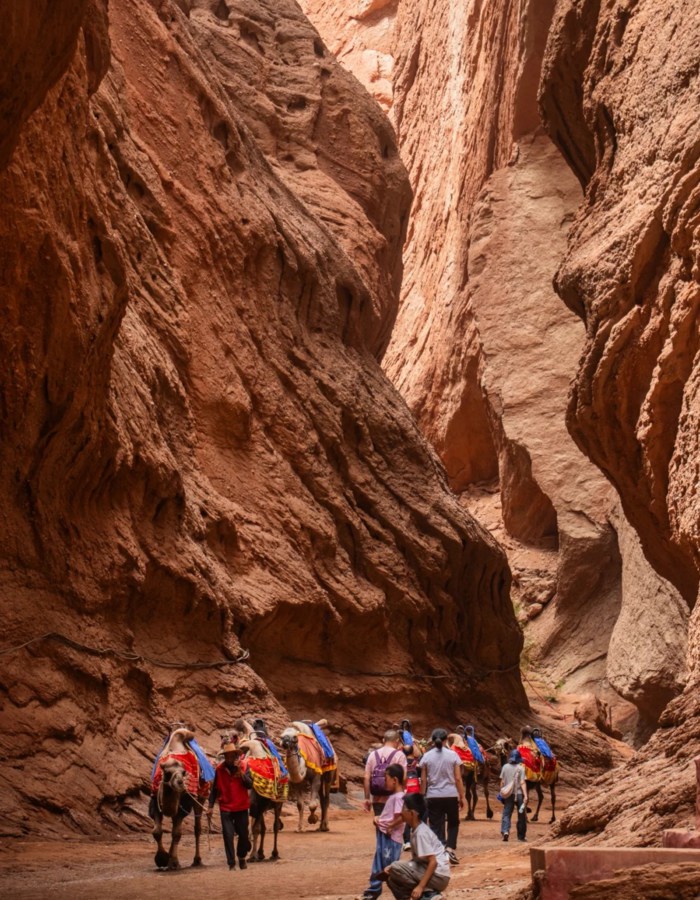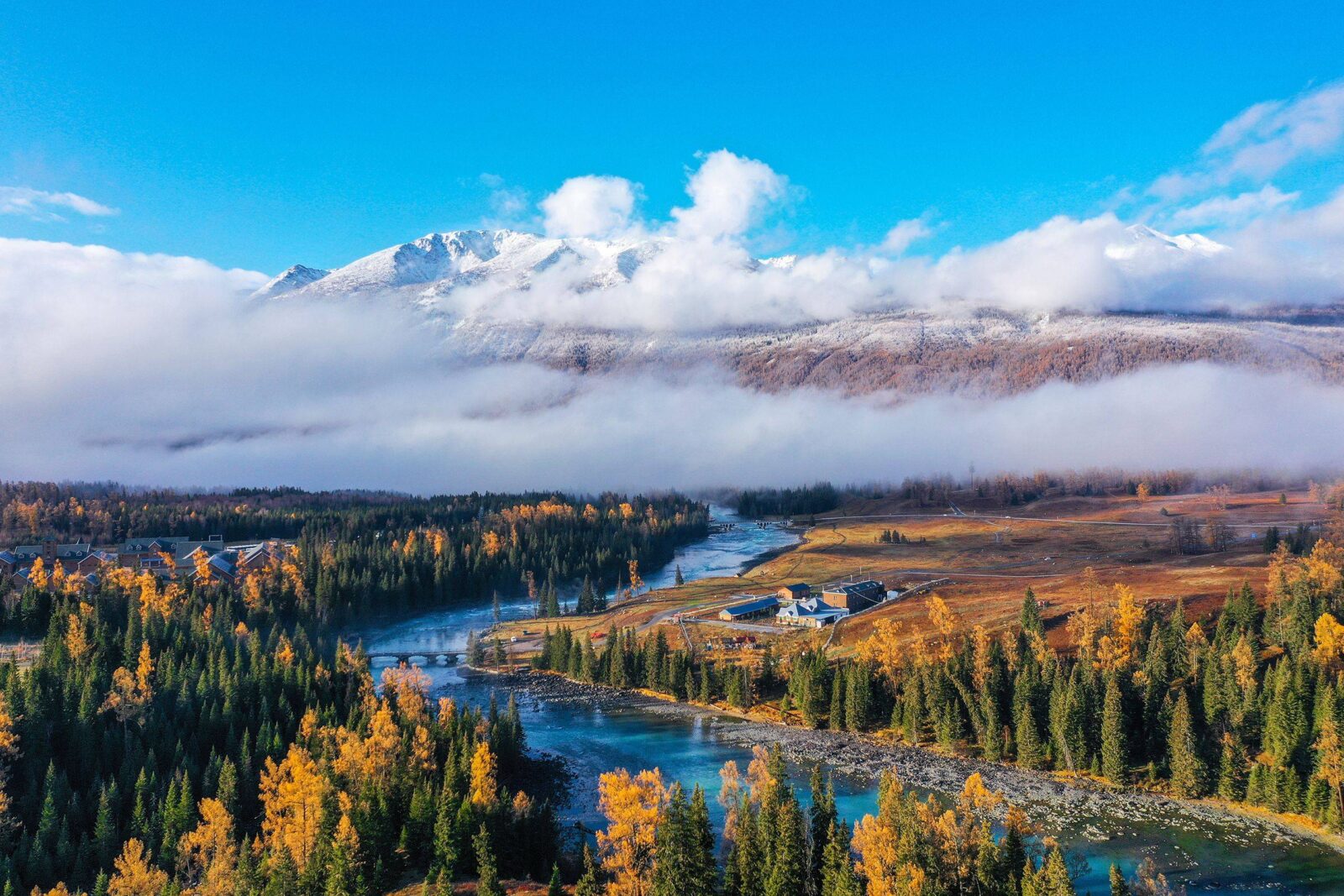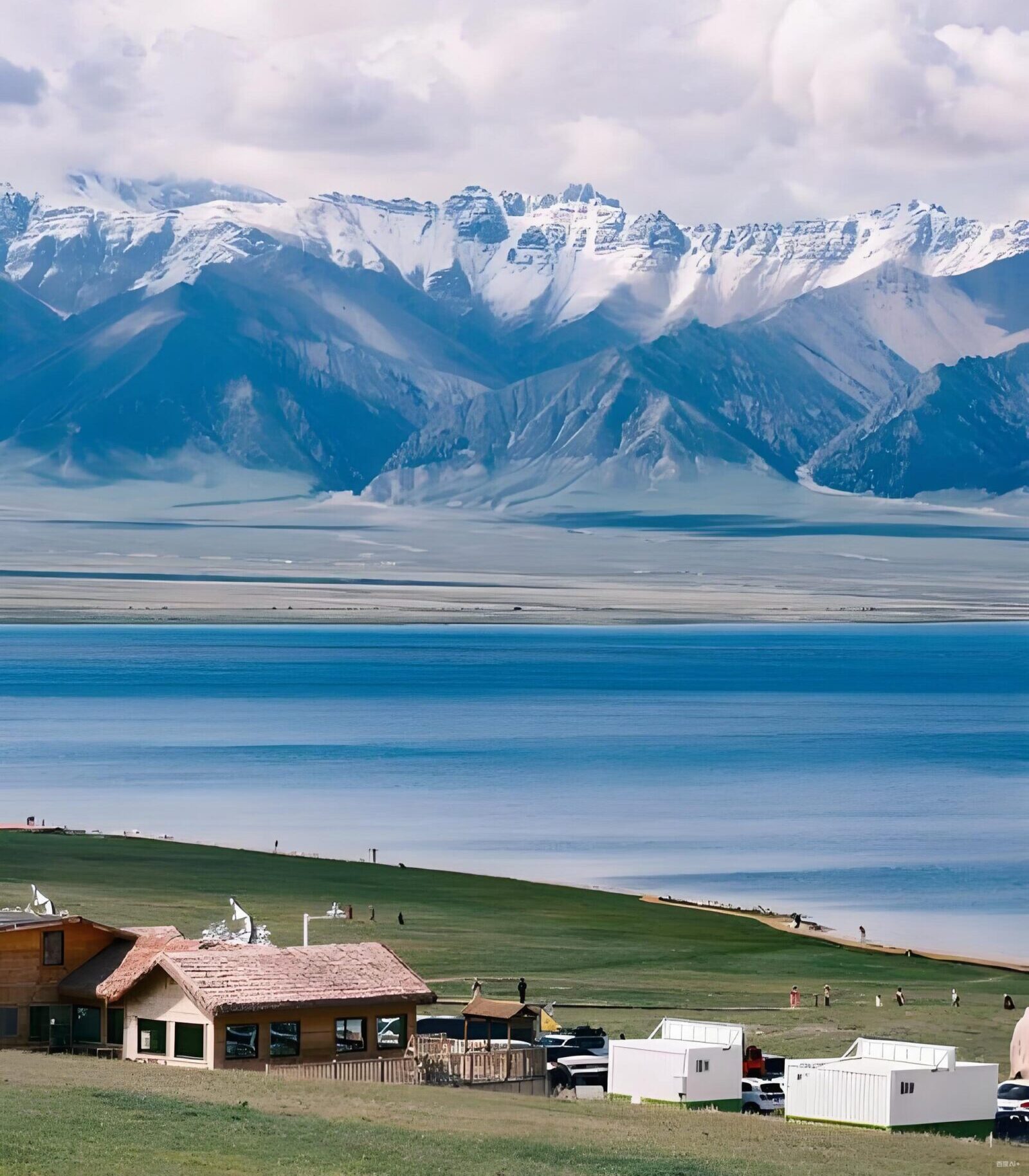
Sailimu Lake
Sailimu Lake lies 2,071 meters above sea level in Xinjiang, northwest of China, and is frequently referred to as the bluest lake in China. It rests under the Tianshan Mountains where the air is thin and the colors intense. Named by the locals as "the last tear of the Atlantic Ocean," Sailimu Lake offers a combination of peace and beauty in its mountain scenery, grassland-temperament and fruits of the nomadic life of the Kazakhs. It is not for poetic mystery, that Sailimu Lake is prized, but for its great expanse, changing seasons and culture.
So here is the relation, if you have ever longed to awaken to mirror-blue water and snowy peaks in the place of nothingness Sailimu Lake should be your next stop. We will chat of how to get there, what kind of sleep one has in a yurt, when to see the wild flowers or ice bubbles, where real Kazakh dishes and not food for the tourist is served. In fact it is just all the things you wished some one had said to you before you started to pack. This will be entirely proper as Sailimu Lake has a convincing way of making the lingerers, linger a long time.
Quick Info: Sailimu Lake at a Glance
| 🏷️ Category | 🗒️ Details |
|---|---|
| 🌊 Names | Sailimu Lake (赛里木湖) / Sayram Lake; Kazakh: Sayram Köl (“Blessing” or “Peace”) |
| 📍 Location | Bole City, Bortala Mongol Autonomous Prefecture, Xinjiang; 90km from Yining, 550km from Urumqi |
| 🗻 Nature | Alpine glacial lake (2,071m elevation), 457 km² area, -1.4°C average temperature, max depth 92m |
| 🌿 Characteristics | “Last tear of the Atlantic,” blue waters, snow peaks, grasslands, diverse alpine ecosystem |
| 🎎 Ethnic Culture | Kazakh nomadic life, yurt hospitality, music, and eagle-hunting festivals |
| 🎡 Activities | Horseback riding, boating, ice festival, and stargazing camps |
| 🏞️ Highlights | Santai Grassland, wildflower meadows (Jun–Aug), ice lake views (Dec–Mar) |
| 🍢 Local Food | Roasted lamb skewers, Kazakh milk tea, handmade naan, dried yogurt, and mare’s milk (Kumis) |
| 🧍♂️ Best For | Nature photographers, campers, cultural explorers, and long-drive travelers |
| 💰 Basic Costs (2025) | Entrance ¥70 (Trip.com); Lodging ¥200–400/night; Budget ¥300–600/day; Best season: Jun–Sep |
| ⚠️ Important Reminders | No open fires; pack warm clothes; respect customs—ask before photos, remove shoes in yurts |
Understanding Sailimu Lake: Location, Legend & History
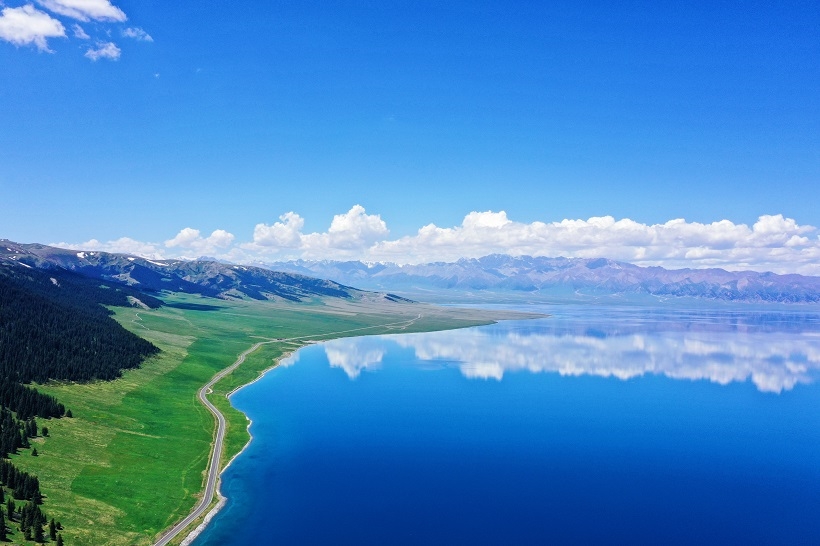
Sailimu Lake in Xinjiang
Where Exactly is Sailimu Lake? Pinpointing Your Destination
Sailimu is situated in the northwestern part of Xinjiang in that area of the Tianshan Mountains that divides the Ili Valley from the Junggar Basin (300 miles) and is situated about 100 kilometers from the borders of Kazakhstan. From Urumqi it is about 550 kilometers (7 hours by auto) along the G30 highway. The lake is in a tectonic depression about 2071 meters in elevation; its length is 30 kilometers from east to west and 25 kilometers from north to south.
According to users on TripAdvisor it is best to call at the lake in the early morning for the best light and use shared taxis from Bole City (50 kilometers southwest) as there are no hotels, restaurants or other conveniences. The G30 highway runs right up to the lake (this particular route was on one of the ancient routes eastward from west Asia along which trafifc of every description has moved for the past 1,50000 years) when suddenly the traveler gets a glimpse of the lake presented before him, a bit of turquoise set off against the brown of the surrounding grass.
While Sailimu opens west toward Kazakhstan, the mountains hide a calmer mirror at Tianchi Lake in Xinjiang’s Tianshan Mountains.
The Legend of "The Last Tear of the Atlantic" & Brief History
Kazakh tradition tells of shepherd Qiemuer and princess Xuelihua, whose forbidden love ended tragically. Unable to be together, they walked into the lake, and it grew larger from their tears, becoming known as Sayram—"blessing" or "peace." The "Atlantic" part stems from mystical beliefs that the lake contains remnants of an ancient ocean covering Central Asia millions of years ago.
Modern science attributes the lake to tectonic faulting during the Quaternary glacial period (2.5 million years ago). But both versions matter—science explains "how," while legend explains "why" this lake holds spiritual significance for Kazakh people. For nomads, Sailimu is where physical and spiritual worlds overlap.
Sailimu's documented history spans nearly a thousand years, with the first written mention in 1219 AD Mongol military records when Genghis Khan's armies passed through. For centuries, Silk Road caravans used it as a landmark. Kazakh and Mongol herders established seasonal grazing patterns—summers at the lake, winters in lower valleys—that continue today.
Top Attractions at Sailimu Lake: The Must-See Spots Around the Circuit
1. Moon Bay (月亮湾) — Where Ice Bubbles Meet Crescent Shores
Moon Bay is located near the East Gate entrance at the crescent shore line. In winter, weird “ice bubbles,” frozen methane bubbles trapped under ice, can be found. In summer, the water is slick that photos made over it in sunsets are beautiful, the sunset being reflected in the water in transfixed brightness. It gives a residence of splendour to the golden-orange light of the evening upon the calm bay.
If you arrive at Moon Bay in peak season, June to August inclusive, half an hour before sunset, you will get relatively decent quarters for viewing purposes. In winter, proper boots with a good grip will have to be utilized in walking upon the ice.
2. Kelayongzhu (克勒涌珠) — The Swan Haven That Never Freezes
The underground springs keep the locality unfrozen, and the swans frequent it in winter, for here are open patches of water which they love to float upon in the ice. The pictures which it suggests are beautiful, as these lovely white birds float on the water amid the ice. The summer is here, too, a time of sureness, the water is there calm and clean—but the fountains to be seen are there and do their spray work—and the reflections are terrific.
Blue ice castles grow around the springs, emitting from them. Kelayongzhu is just fifteen minutes round the bay, travelling clockwise from Moon Bay. There is a small quantity of parking room and viewing platform. Serious wildlife photographers are inclined to frequent this place, particularly in winter, when the swans come.
When Kelayongzhu’s calm gives way to fluttering wings, follow the seagulls to Dianchi Lake, Kunming.
3. Songshutou (松树头) — The High Point View
The summit of the circuit road lies at "Pine Tree Head". A one-kilometer ascent of 150 meters leads to views of the lake in all its magnificence, surrounded by snow-capped mountains. The hills are alive during June-July with purple, yellow and white wild flowers.
Best time: about 5-6 P. M. in summer. The light is softer and the temperature pleasant. Water required-no facilities. Only one or two visitors are met on the way so that it is perhaps the finest place for a scenic view to understand the topography and the size of the lake.
4. Jinhua Zihui (金花紫荟) — The Wildflower Explosion
The densest wildflower concentration around the lake appears here on the northern circuit. Late June through mid-July brings peak blooms—golden buttercups, purple lupines, white daisies so thick you can barely see grass beneath. Swans glide through nearby shallows, creating Instagram-worthy scenes.
Show up for sunrise (around 6:30 AM in summer) to avoid crowds and capture morning dew on flowers. Larger viewing platform with parking and basic restrooms.
5. West Sea Grassland (西海草原) — The Big Sky Country
Sailimu's largest expanse of grassland is vast and open, with endless skies overhead. Yellow flowers of rape-seed oil continue to blossom in July, making an impressive contrast to the blue waters of the lakes. This is the area's chief riding ground, surrounded by several Kazakh families offering rides of anything from 30-minute trots (Y80 to Y100) to half-day excursions (Y300-400).
During the summer, white felt yurt huts cover the grasslands, which are indeed the working camps of the people, who live there while their stock is on the grass. There is no regular parking place; simply pull up where you see the yurt huts and come across the grass. When approaching the camps look for signs announcing "visitors welcome."
6. Dianjiangtai (点将台) — The General's Platform
According to legend, Genghis Khan assessed troops from this rock during 1200s western campaigns. The viewpoint features a 180-degree view from a cantilevered wooden platform over the cliff face. High enough to see distances but low enough to make out details such as individual yurts and shades of water color.
Be early or late to avoid tour groups (11:00 a.m.-3:00 p.m.). Access is from an access road branching from the western shore; 10-minute hike from parking to the viewpoint up a moderate hill.
7. S-Bend Road & Lighthouse — The Instagram Darlings
The S-Bend Road creates perfect leading lines through flower-covered meadows with lake and mountains in frame. Located on the southern circuit, roughly 40 minutes clockwise from East Gate. Best angles come from slightly uphill of the curves. Avoid midday light; aim for early morning or late afternoon.
Safety warning: Don't stand in the highway for photos. Use pullouts and watch for traffic.
The decorative red-topped white lighthouse near South Gate photographs beautifully at sunset. Both locations get crowded with influencers during peak season—arrive very early or skip if crowds annoy you.
8. Santai Grassland (三台草原) — The Peaceful Alternative
A favorite personal haunt with merely 10% of the throngs. Located on the northern circuit away from the primary wildflower areas, this series of terraces rises city-side from the lakeshore toward the mountains. From May till early July flowers prodigiously bloom to rival Jinhua Zihui. In the month of June wild strawberries occur among the grass.
Several families of Kazakhs furnish authentic yurt stay experiences, work-ing pastoral camps that attract visitors. The smooth, open country makes amateur pictures easy without hiking. Morning haze creates aesthetic effect. Watch for the Santai Grassland marker, about 25 minutes clockwise from East Gate.
Experiencing Kazakh Culture at Sailimu Lake
Summer Nomad Camps: What to Expect
- Kazakh Yurts
- The Outside Decoration of Kazakh Yurts
- The Internal Decoration of Kazakh Yurts
Between May and September, Kazakh families move livestock to Sailimu's high pastures. White felt yurts appear across west and north shores—authentic working camps, not tourist reconstructions. Many families welcome tourists, providing income while maintaining traditional lifestyle.
Spending a night by the lake feels almost spiritual. Traditional yurts cost ¥150‑300 per person with meals and give you an authentic yet simple setup—felt mats for beds, shared pit toilets, and sometimes only cold water. Small guesthouses (¥200‑400 per room) add comfort with electricity and private bathrooms, though they fill quickly from June to August. If you bring your own tent, budget ¥50‑100 per person per night and choose a spot sheltered from the strong winds. Staying overnight rewards you with quiet dawns, dazzling star‑filled skies, and warm morning tea shared with herder families. Many camps sit right beside the water, perfect for sunrise photography.
Approaching camps: Look for "visitors welcome" signs. Use friendly "Salam" (hello) and questioning gestures. Many younger family members speak basic Mandarin.
Inside yurts: Remove shoes at entrance (non-negotiable). Accept milk tea offered immediately—refusal seems rude. Sit in the place of honor (directly across from door). If offered food, accept at least a small portion. The experience bridges cultural and language barriers, but most families show remarkable patience.
Traditional Foods You Should Try (and a Few You Might Struggle With)
Gao Baishan Fish (高白鲑鱼): You can’t leave Sailimu Lake without tasting this silky, cold-water fish. Locals say its flavor reflects the purity of the lake itself — delicate, juicy, and never fishy. Try it steamed for a light bite or pan-fried for a crispy edge; a whole fish usually costs ¥80–120, depending on size. Order it at “Dianjiangtai Restaurant” or “Lakeside Home,” where it’s freshly caught and cooked right beside the water.
Hand-Pulled Mutton (手抓羊肉): This one’s pure Xinjiang soul food. Grass-fed sheep from nearby prairies give the meat a clean, tender taste with zero gamey smell. Locals eat it straight from the pot, tearing it apart with their hands and dipping it in salty spice mix. A generous plate runs about ¥60–90, and the best ones come from yurt kitchens where steam fogs up your glasses and laughter fills the air.
Kazakh Pilaf (哈萨克族手抓饭): Warm, oily, and incredibly comforting — this rice dish carries the aroma of lamb fat and slow-cooked carrots. Add a splash of chili oil, and it becomes a small celebration on your tongue. For around ¥40–60, you’ll get a full plate and probably a story or two from the Kazakh host at “The Herder’s Home” by the East Gate.
Xinjiang Baked Bun (新疆烤包子): These golden buns crackle when you bite into them, releasing hot, juicy lamb filling that melts right in. They cost about ¥8–12 each, and you can find them from street stalls near the parking lots to fancy lakefront cafes. Eat one while it’s still steaming — that’s when you’ll really taste Xinjiang.
Activities: Horse Riding & Cultural Experiences
Horseback Riding: Horse riding at Sailimu Lake isn’t a staged show but a genuine part of Kazakh life. Along the circuit road, herder families offer rides using their own working horses—strong, sure‑footed, and accustomed to beginners. Prices range from ¥50‑80 for a short thirty‑minute loop to ¥200‑400 for several‑hour excursions into the hills. The gear is basic, often just a blanket or simple saddle, but that’s part of the charm. Most rides lead to viewpoints unreachable by car, with dawn and dusk offering the best light and comfortable air. Before mounting up, agree on the route, time, and price, and make sure to stay within your skill level; remember that the altitude of 2,071 m can make exertion feel heavier.
Practical Travel Information: Planning Your Visit
Best Time to Visit: Seasonal Breakdown
| Season | Temperature (°C) | Highlights | Notes |
|---|---|---|---|
| June–August (Peak Season) | 15–22°C day / 5–8°C night | Spectacular wildflower displays (late June–early July), clear roads, all facilities open | Most crowded and expensive period |
| September–October (Sweet Spot) | 8–18°C day / -1–5°C night | Autumn colors, golden grass, crisp air | Ideal balance of weather and crowd levels, but early snow may close roads mid-October |
| December–March (Winter) | -20°C or colder | Frozen lake, blue ice ridges, peaceful scenery | Requires 4WD and full winter gear; most services closed, stay in Bole for day trips |
| April–May (Spring) | 0–10°C day / -5–2°C night | Ice melting, shifting lake colors | Unpredictable weather, muddy terrain, least popular season |
Getting There: Transportation Options Explained
By Car: Sailimu Lake lies about 550 kilometers from Urumqi via the G30 highway, taking roughly 7–8 hours. Roads are excellent, but you’ll meet several security checkpoints—keep your ID and passport ready. Car rentals cost ¥250–500 daily, and SUVs are ideal for the mountain routes. International driving permits aren’t accepted, so you’ll need a Chinese license or hire a local driver. Expect ¥800–1,200 daily for full rental costs including fuel and tolls. Jinghe is the last stop for gas before the lake.
By Tour: Urumqi-based tours offer hassle-free travel options. Standard bus tours cost ¥800–1,500 for three days and include key scenic stops, while small private tours range ¥3,000–5,000 for three to four days. These are great if you prefer logistics handled for you, though time at Sailimu Lake may be brief, often during midday light when photos are harsh. Always check recent traveler reviews to find a tour that fits your pace and expectations.
Where to Stay: Accommodation Options Near Sailimu
At the Lake:
Yurt camps (¥150-300/person with meals): Authentic but very basic—felt mats, shared pit toilets, no showers. Wake to mountain views, morning tea with families, incredible stars
Small guesthouses (¥200-400/room): Basic beds, electricity, marginally better bathrooms. Seasonal operation; book ahead June-August
- Advantage: Proximity for sunrise/sunset photography
- Drawback: No WiFi, limited phone signal, simple meals
Bole City (50km Away):
| Category | Price Range | Features | Trade-off |
|---|---|---|---|
| Hotels | ¥150–250 (budget) / ¥350–600 (mid-range) | Clean, functional rooms with hot water and WiFi; near restaurants, grocery stores, and supplies | Early 5:30 AM starts for sunrise and late 9–10 PM returns after sunset |
Balanced Strategy: One night at lake (authentic experience) + nights in Bole (comfort)
What to Pack: Essential Gear List
Clothing Layers: Start with moisture-wicking base layers like synthetic or merino wool. Add a fleece or lightweight insulator for warmth, and top it off with a windproof, waterproof jacket to handle Sailimu Lake’s unpredictable weather. Convertible pants, long underwear, a warm hat, and gloves are smart picks even in summer.
Footwear: Bring sturdy hiking boots for trails and sandals or flip-flops for camp use. The terrain around the lake can shift between rocky paths and soft grass, so comfort and grip matter.
Sun Protection: The altitude at 2,071 meters means UV rays hit harder. Always carry high-SPF sunscreen, SPF lip balm, and wear a wide-brimmed hat with polarized sunglasses. Staying sun-safe makes your journey far more enjoyable.
Essentials: A daypack, reusable water bottles, and energy snacks like nuts or dried fruit are must-haves. Don’t skip a first aid kit, prescription meds, and altitude pills if needed. Pack a headlamp, toiletries, tissues, and sanitizer for long travel days.
Photography Gear: A wide-angle lens and polarizing filter bring out the lake’s deep blue hues. A tripod helps with sunrise or sunset shots, and extra batteries or memory cards are essential. Since outlets are scarce, a reliable power bank is your best friend.
Frequently Asked Questions
Q: What's the best time to visit Sailimu Lake?
The best time to visit Sailimu Lake depends on your goals. Late June brings wildflowers and long days, while September offers golden fields and calm weather. Summer, from June to August, is warm but crowded, and winter turns the lake into a frozen mirror under bright skies. Average highs range from 10°C to 25°C, with 65% of days clear between June and September. Whether you’re into photography or hiking, Sailimu Lake’s beauty always rewards patient travelers.
Q: Do I need special permits to visit Sailimu Lake?
No special permits are needed beyond your Chinese visa and Xinjiang registration. Hotels must register foreign guests, and you’ll pass several checkpoints on the G30 highway, so keep your passport handy. Photography is allowed across the scenic area but avoid police zones. For foreign tourists, Sailimu Lake is among the most accessible places in Xinjiang. You can rent a car or book Ctrip tours from Yining or Bole without complicated paperwork.
Q: How much does it cost to visit Sailimu Lake?
Visiting Sailimu Lake costs roughly ¥400–600 daily per person, including entrance, food, and lodging. Tickets cost ¥70 and are valid for a day. Yurt stays range from ¥150–300 with meals, while Bole hotels average ¥300–600 nightly. Meals near the lake cost ¥50–100, and horseback rides are ¥50–400. Renting a car adds ¥250–500 per day, plus fuel. Tour packages vary between ¥800 and ¥5,000 depending on the itinerary.
Q: What about altitude sickness at Sailimu Lake?
Sailimu Lake lies at 2,071 meters above sea level, a moderate altitude that rarely causes serious symptoms. Some visitors feel mild fatigue or headaches on arrival. Staying hydrated and pacing activities helps. Spending a night in Yining or Bole before ascending makes adjustment smoother. With common sense and good preparation, altitude won’t stop you from enjoying Sailimu Lake’s crisp air and brilliant scenery.
Q: Is Sailimu Lake safe for solo travelers?
Yes, it’s very safe—even for solo female travelers. Xinjiang has strong security and friendly locals. The main challenge isn’t crime but transportation since public transit is rare. Rent a car, share rides, or join a small tour to explore freely. Locals may offer milk tea or bread—it’s hospitality, not a scam. Just inform someone of your route and carry a SIM or eSIM for emergencies.
Q: Can I visit Sailimu Lake in winter?
Yes, but expect serious cold. Sailimu Lake freezes completely, creating blue ice ridges that photographers love. Daytime temperatures hover near -10°C, dropping below -20°C at night. Bring full winter gear and travel in a 4WD with snow chains. Most yurts close, so staying in Bole and making day trips is smarter. The lake’s winter silence is haunting yet beautiful, perfect for those chasing Xinjiang’s frozen charm.
Q: Are there restaurants near Sailimu Lake?
Food options are simple but satisfying. During summer, stalls near viewing areas serve kebabs, noodles, and tea for ¥30–50. Staying with Kazakh hosts brings homemade stews, naan, and milk tea—a must-try cultural experience. In Bole City, restaurants offer richer menus with pilaf, lamb skewers, and noodles for ¥40–80. Bring snacks and water if visiting off-season since vendors close by October.
Q: What wildlife might I see at Sailimu Lake?
The grasslands around Sailimu Lake teem with life. You’ll spot marmots, foxes, bar-headed geese, and golden eagles. In migration months, cranes and ducks rest by the shores, creating perfect photo moments. Early mornings are best for sightings, especially near wetland edges. Avoid loud noise—animals here are shy but visible to quiet observers. Fishing is banned to protect the lake’s fragile ecosystem.
Q: How do I respect local Kazakh culture?
Locals are generous and welcoming. Greet with “Salam,” remove shoes before entering yurts, and always accept offered tea. Dress modestly and ask permission before photographing people or homes. Avoid alcohol and pork as gifts, and bring small tokens like chocolate or tea instead. Respectful behavior and curiosity open doors to meaningful exchanges.

